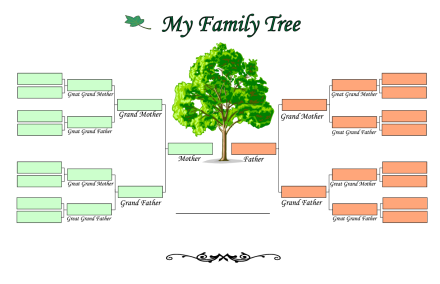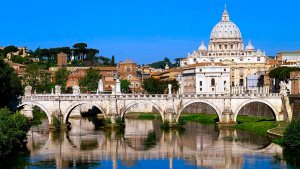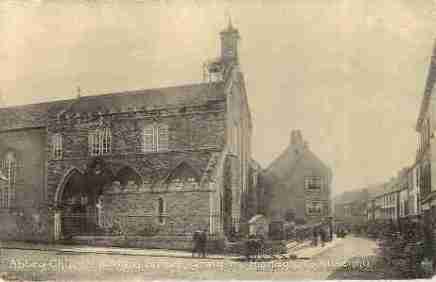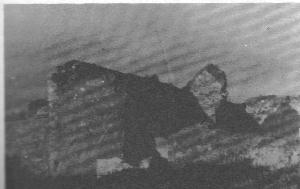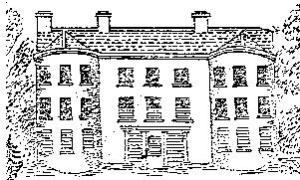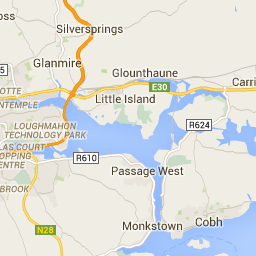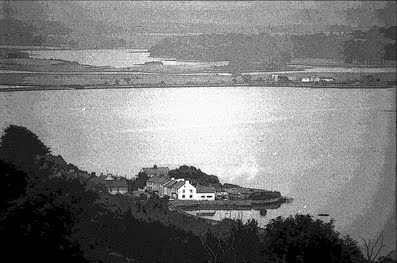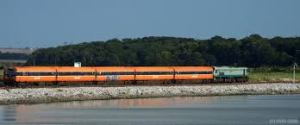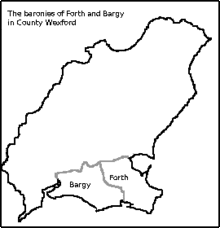
Mogeely, near Castlemartyr, County Cork, as photographed by the Horgan brothers of Youghal before 1910.
This blog has already featured a postcard sent from Queenstown (now Cobh) to Ladysbridge in 1904 (see ‘The history that is lost to us as hinted in an old postcard.’ Posted January 2nd.) However, the postcard discussed in today’s post is, perhaps, more interesting, both for its local provenance and its pictorial subject matter. it makes your realise that before the age of texting, even before telephones became commonplace, the half-penny postcard was the way to send a quick message.
The card was sent by someone called ‘Katty’ to Miss Ciss Donovan in Ladysbridge. The postmark on the green half-penny stamp depicting King Edward VII is dated May 3rd, 1910. This mark was impressed on the card at Castlemartyr Post Office at 8.15 pm that evening, clearly in preparation for delivery the following morning. It is almost certain that the card was actually posted in Mogeely, and stamped with the postmark during sorting in Castlemartyr. One other detail is of interest – the divided back of the postcard indicates that the card could not have been produced before 1902, for that was the year in which the Post Office introduced the divided back to separate the address from the message.
There are two locations called Mogeely in East Cork – one is near Conna, not far from the Waterford county boundary and the town of Tallow; the other is further south in the barony of Imokilly, about six or seven miles east of Midleton and just a over a mile north of Castlemartyr. This small village of Mogeely, really a hamlet in 1910, is barely three miles due north of Ladysbridge, the destination of the postcard; Castlemartyr is situated on the road between them.
The front of the card consists of a photograph the Horgan brothers of Youghal, famous local photographers and early cinema operators. They opened the first cinema in Youghal, but, more importantly, they took photographs of the towns and villages throughout East Cork and West Waterford in the first half of the twentieth century. In the evening, having taken their photographs, the Horgan brothers would retire to a local hostelry to present a slide show of the images to the local people as a way of saying thank you, and providing an early form of pre-cinema entertainment. Indeed such a show may have been the subject of the postcard’s message. Their signature is on the bottom right of the photograph.

Mogeely photograph close-up. The road to Dungourney heads due north, directly ahead. The road to Killeagh and Youghal veers off to the right (east). Behind the photographer is the road south to Castlemartyr, with the railway line crossing the road immediately behind the position of the camera. Just south of the railway line, the direct route to Midleton heads west (left). The telegraph pole and the pub sign are the only concessions to modernity in the image. At the time the new church was being constructed to the photographer’s immediate right. (Image by the Horgan Brothers of Youghal.)
In this case the photographer has placed his heavy tripod box camera in the middle of the road leading from Castlemartyr to Mogeely. The site is very specific, because this road was crossed by the Cork to Youghal railway line directly behind the cameraman! Furthermore, it can be noted that the road is dusty, because there were very few motorcars in Ireland at the time and the roads were all designed for horse-drawn transport. There is no way a modern cameraman would take such a photograph today without all sorts of signs and traffic cones to ward off the busy rural traffic. The camera faced directly north into the village (really a large hamlet) of Mogeely. The road continuing due north between the cottages and the hedgerow trees leads to Dungourney, situated in the hills that can be discerned between the trees in the background. The road leading to the right heads east to Killeagh and Youghal. Behind the photographer, and beyond the railway line, there is a road leading to the left, west to Midleton. This road joins the main road from Midleton to Castlemartyr and Youghal at Churchtown North, two miles from Midleton.
Because of the nature of the cameras at the time, it was necessary for the photographer to get the co-operation of the local people. The subjects had to stand still for a few moments while the camera captured the image – and this is what happened with this photograph of Mogeely. As you can see the people of the small village are present in force. They are posed in groups – a small group by the pub on the left, a larger group by the cottages in the background in the centre, and a man with his donkey in the middle of the road in front of them. There is another man stepping onto the roadway on the right, and in front of him a village dog got in on the act by posing perfectly on the road!
There are only two buildings in the photograph that have more than one storey. All the rest of the village consists of single-storey dwellings, many of them thatched. What is interesting in this image is that the only concessions to modernity are the telegraph pole on the left, and the name of the pub – the Railway Saloon, otherwise the village looks very much like it did before the railway arrived in the 1860s.

The romanesque revival church of the Sacred Heart in Mogeely was being built when the postcard was sent in 1910. Opened in 1912, its decoration was completed over many years. My great -great-grandfather cut the stone for this church, which was built by JJ Coffey & Sons of Midleton. The church stands beside the road to Castlemartyr, just north of the railway line.
To make matters more interesting, the photographer avoided any suggestion of the biggest event in the village’s history at the time – the building of the new Sacred Heart Church to replace the humble old village chapel. The site of the new church was immediately to the right of the photographer, out of picture. This church was started in 1908 and completed in 1912.

The green half-penny stamp depicts King Edward VII. The divided back postcard was introduced by the Post Office in 1902. Sadly, Miss Ciss Donovan does not appear on the 1911 Census for Ladysbridge. (Postcard in a private collection)
The message on the reverse of the card from Katty to Ciss Donovan says:
Thank you very much for your lovely nib. I hope you enjoyed the play. I heard the machine got broken. It was fair in Mogeely. In the upper left corner the message ends: Hope to see you on Sunday.
Presumably the nib in question is the one that was used to write the message and address in red ink. The ‘play’ is likely to be the slide show put on by the Horgan brothers that evening, presumably in Ladysbridge for the locals there. The reference to the ‘machine’ breaking down suggests that there was a technical hitch during the show. And the note that ‘it was fair in Mogeely’ does indeed suggest that the breakdown happened during a show in Ladysbridge – it’s hardly a reference to the weather given the proximity of the two villages! Finally, Sunday was the normal day for visiting and greeting friends and family, being the only day off during the week. Since I have family connections to Ladysbridge, I would love to see the slides that the Horgan brothers showed that evening in Ladysbridge. I’m not certain if they are among those images from the Horgan Collection made available online by the Cork County Library.
Unfortunately Miss Ciss Donovan is not named in the 1911 census for Ladysbridge – she had either moved away, or married and moved away. As for Kattie – there are several candidates. However, I suspect, but cannot prove that our Kattie may be Kate Harte, aged 30, of House 7 in Mogeely, wife of the blacksmith John A Harte.
Mogeely’s history goes back a long way – it was certainly extant when Robert FitzStephen and his band of knights invaded Cork in 1177. The site was almost certainly a parish by that time and fragmentary remains of the medieval church are extant in the local graveyard. Mogeely seems to have been the seat of the local ruling family, the Ui Mac Tire, before the Anglo-Normans arrived. In 1182, the Mac Tire clan murdered a party of five Anglo-Norman knights, on their way to a parley in Waterford, sparking off a general revolt against the invaders in Cork. In the 1640s a senior Anglican clergyman, collecting evidence of Catholic atrocities against Protestants during the 1642 rebellion was murdered nearby. These murders will be the subject of a future post.

The fragmentary remains of the medieval parish church of Mogeely are situated in the centre of the grossly overcrowded old graveyard. When the new church was completed in 1912, the old early 19th century chapel next to this graveyard was taken down and its site was later incorporated into the graveyard. My grandparents were buried in this new section.
Both Mogeely and Ladysbridge have expanded considerably since the postcard was sent in 1910. This is due to the building of housing estates on the edges of the villages. But the centre of each village is pretty much as it was in 1910.
Now I must declare a personal connection to both Mogeely and Ladysbridge. At the time the postcard was sent, Mogeely’s new church was being constructed by the firm of JJ Coffey & Sons of Midleton. My own great great grandfather on my mother’s side was a stonecutter who worked for Coffey’s. He cut and dressed stone for this church. My paternal grandparents came from Wexford, but eventually settled in Ladysbridge. Both are buried in Mogeely graveyard.
My thanks to Jim Horgan of Youghal for encouraging me to publish the images of the postcard, and to my aunt loaning it to to me..
More images from the Horgan Collection can be viewed on the website of the Cork County Library:
http://www.corkcoco.ie/co/web/Cork%20County%20Council/Departments/Library%20&%20Arts%20Service
The Horgan Collection can be found under the library’s Digital Collections link.
If you recognize any scene or any person depicted in these images, please be so good as to inform the Cork County Library at: corkcountylibrary@corkcoco.ie
